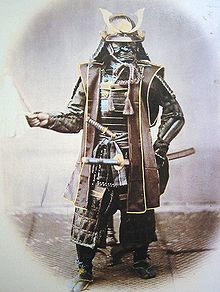Geisha, geiko or geigi are traditional Japanese female entertainers who act as hostesses and whose skills include performing various Japanese arts such as classical music, dance, games and conversation, mainly to entertain male customers.
Tag: Japan
What is a Samurai?
Samurai were the military nobility of medieval and early-modern Japan.
In Japanese, they are usually referred to as bushi. According to translator William Scott Wilson: “In Chinese, the character was originally a verb meaning to wait upon or accompany persons in the upper ranks of society, and this is also true of the original term in Japanese, saburau. In both countries the terms were nominalized to mean “those who serve in close attendance to the nobility”, the pronunciation in Japanese changing to saburai. According to Wilson, an early reference to the word “samurai” appears in the Kokin Wakashū (905–914), the first imperial anthology of poems, completed in the first part of the 10th century.
By the end of the 12th century, samurai became almost entirely synonymous with bushi, and the word was closely associated with the middle and upper echelons of the warrior class. The samurai were usually associated with a clan and their lord, and they followed a set of rules that later came to be known as the bushidō. While the samurai numbered less than 10% of then Japan’s population, their teachings can still be found today in both everyday life and in modern Japanese martial arts.
What is a Yamabushi?
Yamabushi (one who lies in the mountains) are Japanese mountain ascetic hermits with a long tradition, endowed with supernatural powers in traditional Japanese mysticism. They follow the Shugendō doctrine, an integration of mainly esoteric Buddhism of the Shingon sect, with Tendai Buddhist, Taoism, and Shinto elements. For the most part solitary, they did form loose confederations, and associations with certain temples, and also participated in battles and skirmishes alongside samurai and sōhei warrior monks on occasion. Their origins can be traced back to the solitary Yama-bito and some hijiri of the eighth and ninth centuries.There has also been cross-teaching with samurai weaponry and Yamabushi’s spiritual approach to life and fighting.
In modern use, the term ubasoku-yamabushi refers to laymen practitioners of shugendō. The religion places a heavy emphasis on asceticism and feats of endurance, and white and saffron-robed yamabushi toting a horagai conch-shell trumpet are still a common sight near the shugendō holy site of Dewa Sanzan and in the sacred mountains of Kumano and Omine.
What is a Tosa?
The Tosa has been bred for hundreds of years in Japan. The country has a long history of dog fighting, beginning in the 14th century. It was developed between the period of 1868 and 1912 by crosses with the Kochi (a local Japanese breed), native Shikoku fighting dogs, with Western breeds such as the German Pointer, Mastiff, Great Dane, Bulldog, St. Bernard and the Bull Terrier. Tosas were often referred to as the “Sumo wrestler of the dog world.” In Japan, the Tosa is considered a national treasure. Although dog fighting is now illegal in Europe, North America, and Japan, secret, illegal pit fights continue in remote rural regions of Japan, where the Tosa, at 66-88 pounds (30-40 kg.)—smaller than those bred in the West—is still used for fighting. The breed excels at Japanese-style dog fighting. Japanese dog-fighting rules in the last century demanded that dogs fight silently, without cowering, and the Tosa fought by these rules—relentlessly and silently. The Tosa is a rare breed, even in its native land and has only recently been introduced to the USA. Unfortunately, this breed is banned in some countries as a dangerous breed. It is definitely unsuitable for beginners, but with the proper socialization, handling and training, it can make a wonderful family companion. This massive dog excels at weight-pulling and makes a great watch and guard dog.
What is a Cherry Blossom?
A cherry blossom is the flower of any of several trees of genus Prunus, particularly the Japanese Cherry, Prunus serrulata, which is called Sakura after the Japanese.
Cherry blossom is speculated to be native to the Himalayas. Currently it is widely distributed, especially in the temperate zone of the Northern Hemisphere including Europe, West Siberia, China, Korean Peninsula, Japan, Canada and the United States. In the Western world, the cherry blossom symbolizes Japan.
Many of the varieties that have been cultivated for ornamental use do not produce fruit. Edible cherries generally come from cultivars of the related species Prunus avium and Prunus cerasus. Cherry blossom are also closely related to other Prunus trees such as the almond, peach, plum and apricot and more distantly to apples, pears and roses.




